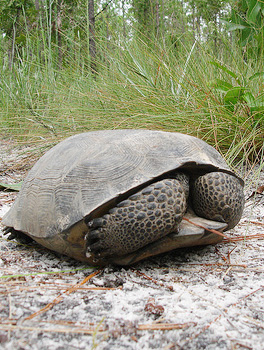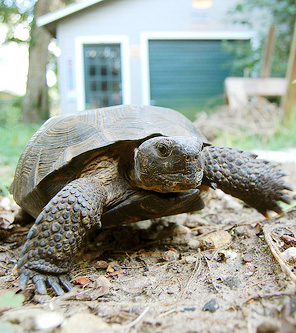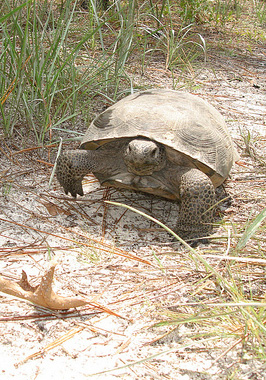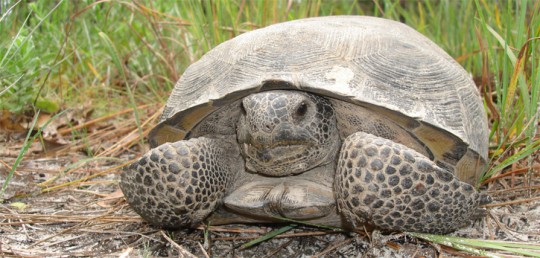Gopher Tortoises Emerging, New Wildlife Conservation Efforts Aim To Protect
April 25, 2012
As gopher tortoises are emerging across the North Escambia area, the Florida Fish and Wildlife Conservation Commission is offering information and tips to protect the species, while the USDA’s Natural Resources Conservation Service in Florida is taking applications from landowners for technical and financial assistance to restore and protect the gopher tortoise habitat.
Gopher tortoises move slowly through ‘spring training’ of grazing, burrow-digging
The gopher tortoise is emerging from winter dormancy and moving slowly and steadily through the landscape in search of greenery to eat and a new place to dig its burrow.
 Look for gopher tortoises’ distinctive domed brown shells and stumpy legs, as these land-dwellers make their way through Florida’s open canopy forests and sandy areas. The Florida Fish and Wildlife Conservation Commission (FWC) asks people to remember that gopher tortoises are good neighbors, so leave them and their burrows alone.
Look for gopher tortoises’ distinctive domed brown shells and stumpy legs, as these land-dwellers make their way through Florida’s open canopy forests and sandy areas. The Florida Fish and Wildlife Conservation Commission (FWC) asks people to remember that gopher tortoises are good neighbors, so leave them and their burrows alone.
“The Florida Fish and Wildlife Conservation Commission works with, and is grateful to, the homeowners, landowners, businesses and public agencies willing to share their lands with gopher tortoises and their burrows,” said Deborah Burr, the FWC’s gopher tortoise plan coordinator. “This state has made progress in reversing the decline of gopher tortoises by providing direction to developers, including re-locating tortoises if necessary, and help to people interested in making room for tortoises.”
Since the Gopher Tortoise Management Plan took effect in 2007, an annual average of 36,000 acres of gopher tortoise habitat has been restored and managed; protected tortoise habitat expanded by more than 6,500 acres; and more than 4,000 gopher tortoises were humanely relocated from development sites.
 “In addition to changes in Florida’s economy, the needs of the gopher tortoise have changed since the plan was first approved in 2007,” Burr said. “The proposed revisions to the plan include new actions that the FWC and our partners can implement together to improve the status of the species, and help secure viable populations well into the future.”
“In addition to changes in Florida’s economy, the needs of the gopher tortoise have changed since the plan was first approved in 2007,” Burr said. “The proposed revisions to the plan include new actions that the FWC and our partners can implement together to improve the status of the species, and help secure viable populations well into the future.”
In Florida, it is illegal to harm gopher tortoises or their extensive burrows, which provide shelter to more than 350 other native species. Generally, the only time people should pick up and move a gopher tortoise is to help it get across a road. Remember, though, not to put the tortoise in your car. Do point the tortoise in the same direction it was going when you picked it up, but never put it in the water because it is a land animal.
The gopher tortoise can live 40-60 years in the wild.
New Wildlife Conservation efforts to protect gopher tortoise habitat
The USDA’s Natural Resources Conservation Service (NRCS) in Florida is currently taking applications for technical and financial assistance on a new innovative partnership approach to restore and protect the habitat for targeted threatened and endangered species, while also helping other vulnerable and game species. Florida landowners can sign-up for assistance to help manage and restore habitat for the gopher tortoise.
 Interested producers and landowners in Florida can enroll in the Wildlife Habitat Incentive Program (WHIP) on a continuous basis at their local NRCS field office. NRCS funds from WHIP will share the cost of conservation practices with landowners. All eligible applications received by the application cutoff date of April 30, 2012 will be assigned a priority and ranked as needed. If funds are available a second ranking cut-off date will be May 30, 2012.
Interested producers and landowners in Florida can enroll in the Wildlife Habitat Incentive Program (WHIP) on a continuous basis at their local NRCS field office. NRCS funds from WHIP will share the cost of conservation practices with landowners. All eligible applications received by the application cutoff date of April 30, 2012 will be assigned a priority and ranked as needed. If funds are available a second ranking cut-off date will be May 30, 2012.
Escambia County’s NRCS field office is located at 151 Highway 97 in Molino. For more information, call (850) 587-5345. In Santa Rosa County, the NRCS field office is located at 6277 Dogwood Drive in Milton, call (850) 623-2441.
Submitted photos for NorthEscambia.com, click to enlarge.
Comments
10 Responses to “Gopher Tortoises Emerging, New Wildlife Conservation Efforts Aim To Protect”




Growing up in escambia county Alabama, I had gophers as pets in the mid sixties. I always eventually released them. Sadly, I never see them in the wild much anymore. Hope this program and public awareness returns the health of the population.
After doing a little reading I was surprised at just how little I know about Gophers.
I have added the NRCS Field Office number to my directory and will just move the
gopher off the road and then call the experts. Next time, which I hope is often.
In a very old edition of National geographics (1950’s) that my husband came across had a recipe for turtle soup. How far we have come
You know it’s coming. When those sick-o’s aim their vehicles to hit them.
It is stomache churning, and heart breaking to see the tortiose’s broken bodies on the road.
I have saved so many of these fellows from the soup pot that I can’t keep track. All of the old timers love the gopher soup. Gophers are such gentle, sweet creatures.
Many years ago, I found a gopher tortoise attempting to commit “gophercide” by crossing Nine Mile Road, near University Parkway. Knowing some people would consider this animal a target, I picked it up and took it home. I gave it a secure home for several years. I learned a lot about this critter. We noted the times it went into hibernation, and came out of it’s burrow. We found out how to determine its sex. HE would follow you around the yard for a tomato, or a grape. Somebody told me I was in violation of the law by keeping him because he was an endangered species. I assured them, this one was in no way endangered. After all I had torn a federal tag off of a mattress, and felt I was bullet proof. Alas, puberty set in for this little fellow, and he set off to follow the natural instincts of nature. I hope he did not become a “Hoover chicken.”
REGARDING:
“he would have wound up in Buford’s Dutch oven.”
Lots of people used to like to eat them but it certainly never struck me as sporting.
David for tofu
(not that tofu can put up a fight either)
I actually had a couple of young men pull up in my yard and ask if they could put a “turtle” they had found in the woods into the lake that I live on! I informed them that it was not a turtle and would probably drown if they put it in the lake, I also told them they would face some serious fines if caught with a gopher tortoise in their possession, they thought I was pulling their leg!
Last year it broke my heart to see two of these turtles had been hit by cars on hwy. 95A north. I think cars are more of a problem for the animals than predators out here. Not sure what can be done about that. I had one turtle eating in my garden in the morning…he really wasn’t hurting anything much…I didn’t begrudge him the food. I shared.
I observed a gopher crossing 95A last summer. I stopped and placed the tortise in the floorboard of my vehicle and drove the gopher to the wildlife management property on Jack’s Branch Road.
Before releasing the gopher I informed it that this was it’s lucky day as Old Buford
would have come driving along 95A and that he would have wound up in Buford’s
Dutch oven.